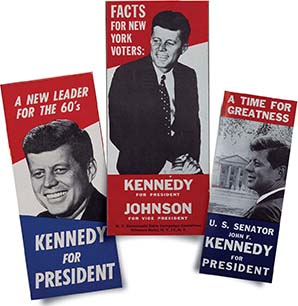SECTION 1: Kennedy and the Cold War
WITNESS HISTORY  AUDIO
AUDIO
The Democratic Candidate
During the election of 1960, John F. Kennedy’s Catholicism became an important issue. Some Americans openly questioned whether a Catholic was independent enough from his church to serve as President. Kennedy dismissed such questions, insisting that a candidate’s religion should not be a factor in running for office:
“I am not the Catholic candidate for President. I am the Democratic Party’s candidate for President, who happens also to be a Catholic.”
—John F. Kennedy, address to Southern Baptist Leaders, 1960
Objectives
- Explain the steps Kennedy took to change American foreign policy.
- Analyze the causes and effects of the Bay of Pigs invasion and the Cuban Missile Crisis.
- Assess the results of the Berlin Crisis and other foreign-policy events of the 1960s.
Terms and People
- John F. Kennedy
- Richard M. Nixon
- Fidel Castro
- flexible response
- Peace Corps
- Alliance for Progress
- Bay of Pigs invasion
- Cuban missile crisis
- Nikita Khrushchev
- hot line
- Nuclear Test Ban Treaty
- Berlin Wall
NoteTaking
Reading Skill: Understand Effects As you read, list the Cold War crises Kennedy faced and the effects of each event.
| Cold War Crisis | Result |
|---|---|
| Bay of Pigs Invasion | |
Why It Matters As the Cold War continued into the 1960s, Kennedy took office facing the spread of communism abroad and the threat of nuclear war. Determined to succeed where he felt Eisenhower had failed, Kennedy’s enthusiasm and commitment to change offered the hope that with hard work and persistence the United States could win the Cold War. Section Focus Question: How did Kennedy respond to the continuing challenges of the Cold War?
Kennedy Defeats Nixon in 1960
For eight years, President Dwight Eisenhower had presided over a nation that had generally enjoyed peace and prosperity. But even so, there were a number of issues that caused Americans grave concern. The launch of Sputnik 1 showed that the rivalry between the United States and the Soviet Union was still intense. The U-2 spy plane incident demonstrated that the Cold War might heat up at a moment’s notice. The Montgomery bus boycott provided clear evidence that the Brown decision had not ended racial discrimination in the land. Deep, unsettled problems remained—problems for a new decade and a new generation of political leadership.
The Candidates
In the presidential election of 1960, Democrat John F. Kennedy and Republican Richard M. Nixon were quite similar in a variety of ways. For the first time in U.S. history, both candidates had been born in the twentieth century, Nixon in 1913 and Kennedy in 1917. Both had served in the navy during World War II.





